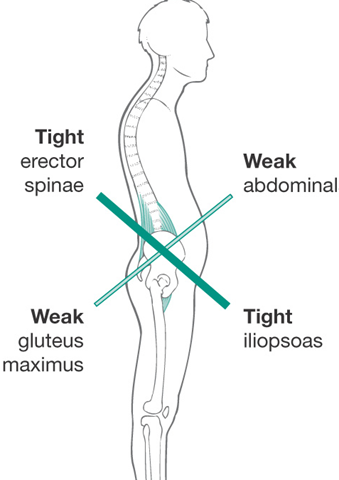What is Lower Cross Syndrome?
LOWER CROSS SYNDROME:
Over the course of our lifetime, experiencing things like childbirth, past injuries, poor sitting and standing habits, our bodies (fortunately and unfortunately) have the innate ability to adapt.
However, these adaptations can lead to postural syndromes that can wreak havoc on our skeletal structures. Add to that, left to right imbalances and there is a recipe for disaster.
Lower Cross Syndrome is a condition that was first coined by Vladimir Janda, a world-renown physical therapist, as a postural situation that involves the shortening and tightening of certain muscles and lengthening and weakening of others. We will discuss Upper Cross Syndrome in another segment of our Fitness Tip of The Week.
In Lower Cross Syndrome, the abdominal muscles get weaker as do the glutes (butt cheek muscles, which, by the way, should be the STRONGEST in our system!), and the hip flexors and lower back muscles get shorter and tighter.
A simple way to assess this is to have someone take a picture of you (tank top/t-shirt and shorts, no socks or shoes) from the side and using a type of plumb line dropped from the ceiling, using it as a reference point, and see what position your pelvis/lower back is in. Do not be on your best behavior and stand super tall…after all we ALWAYS want to see what you look like as if no one was looking! That is the most unbiased way of performing this assessment.
A simple way to correct for this imbalance is to address, stretch and lengthen all the shortened muscles and strengthen the long, weak muscles. It sounds easy enough to do and it actually shouldn’t be hard.
Therefore follow these steps to get you on your way:
Stretch your psoas muscles (on one bent knee as if to propose)
Strengthen your glutes by working on hip extension exercises (example: squats working so that your hips drop below your knees
Strengthen your torso by doing an array of planks (front, side, anti-rotation planks, etc)
Don’t forget that training and conditioning for fitness should ALWAYS include postural corrections to reinforce your posture further! You will feel taller, look better, and have less chronic irritations because your body is not fighting hard to correct your position when enjoying your activities!
If you would like to have your posture assessed and be given the right “blend” of stretching and strengthening exercises for your posture, give us a call and we will set you “straight”!




